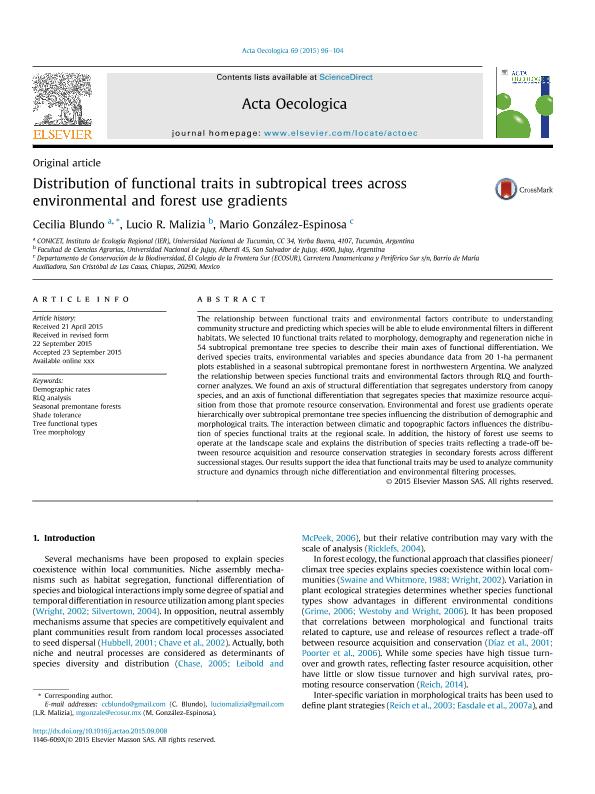Mostrar el registro sencillo del ítem
dc.contributor.author
Blundo, Cecilia Mabel

dc.contributor.author
Malizia, Lucio Ricardo

dc.contributor.author
González Espinosa, Mario
dc.date.available
2018-05-09T14:02:51Z
dc.date.issued
2015-11
dc.identifier.citation
Blundo, Cecilia Mabel; Malizia, Lucio Ricardo; González Espinosa, Mario; Distribution of functional traits in subtropical trees across environmental and forest use gradients; Gauthier-Villars/Editions Elsevier; Acta Oecologica; 69; 11-2015; 96-104
dc.identifier.issn
1146-609X
dc.identifier.uri
http://hdl.handle.net/11336/44572
dc.description.abstract
The relationship between functional traits and environmental factors contribute to understanding community structure and predicting which species will be able to elude environmental filters in different habitats. We selected 10 functional traits related to morphology, demography and regeneration niche in 54 subtropical premontane tree species to describe their main axes of functional differentiation. We derived species traits, environmental variables and species abundance data from 20 1-ha permanent plots established in a seasonal subtropical premontane forest in northwestern Argentina. We analyzed the relationship between species functional traits and environmental factors through RLQ and fourthcorner analyzes. We found an axis of structural differentiation that segregates understory from canopy species, and an axis of functional differentiation that segregates species that maximize resource acquisition from those that promote resource conservation. Environmental and forest use gradients operate hierarchically over subtropical premontane tree species influencing the distribution of demographic and morphological traits. The interaction between climatic and topographic factors influences the distribution of species functional traits at the regional scale. In addition, the history of forest use seems to operate at the landscape scale and explains the distribution of species traits reflecting a trade-off between resource acquisition and resource conservation strategies in secondary forests across different successional stages. Our results support the idea that functional traits may be used to analyze community structure and dynamics through niche differentiation and environmental filtering processes.
dc.format
application/pdf
dc.language.iso
eng
dc.publisher
Gauthier-Villars/Editions Elsevier

dc.rights
info:eu-repo/semantics/openAccess
dc.rights.uri
https://creativecommons.org/licenses/by-nc-sa/2.5/ar/
dc.subject
Demographic Rates
dc.subject
Rlq Analysis
dc.subject
Seasonal Premontane Forests
dc.subject
Shade Tolerance
dc.subject
Tree Functional Types
dc.subject
Tree Morphology
dc.subject.classification
Otras Ciencias Biológicas

dc.subject.classification
Ciencias Biológicas

dc.subject.classification
CIENCIAS NATURALES Y EXACTAS

dc.title
Distribution of functional traits in subtropical trees across environmental and forest use gradients
dc.type
info:eu-repo/semantics/article
dc.type
info:ar-repo/semantics/artículo
dc.type
info:eu-repo/semantics/publishedVersion
dc.date.updated
2018-05-04T16:49:04Z
dc.journal.volume
69
dc.journal.pagination
96-104
dc.journal.pais
Francia

dc.journal.ciudad
Paris
dc.description.fil
Fil: Blundo, Cecilia Mabel. Universidad Nacional de Tucumán. Instituto de Ecología Regional. Consejo Nacional de Investigaciones Científicas y Técnicas. Centro Científico Tecnológico Conicet - Tucumán. Instituto de Ecología Regional.; Argentina
dc.description.fil
Fil: Malizia, Lucio Ricardo. Universidad Nacional de Jujuy. Facultad de Ciencias Agrarias; Argentina
dc.description.fil
Fil: González Espinosa, Mario. Departamento de Conservación de la Biodiversidad; México
dc.journal.title
Acta Oecologica

dc.relation.alternativeid
info:eu-repo/semantics/altIdentifier/doi/https://dx.doi.org/10.1016/j.actao.2015.09.008
dc.relation.alternativeid
info:eu-repo/semantics/altIdentifier/url/https://www.sciencedirect.com/science/article/pii/S1146609X15300230
Archivos asociados
